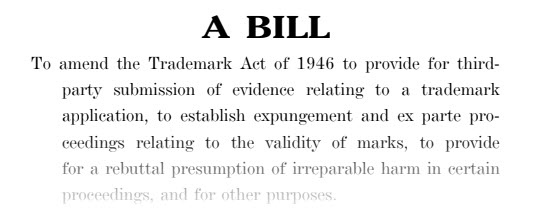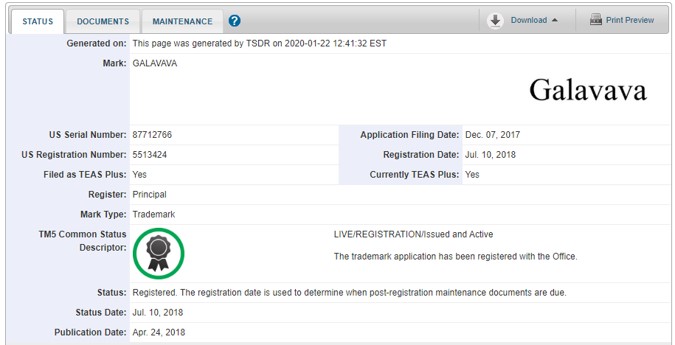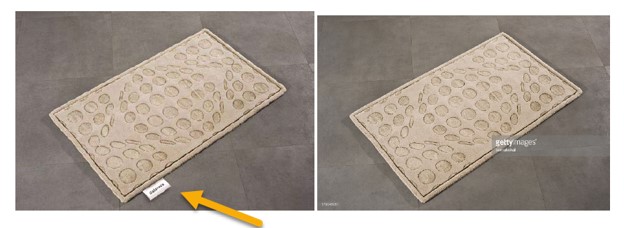Trademark Modernization Act of 2020: How Proposed Legislation Could Clear the Way for Your Trademark

The U.S. House and Senate recently introduced the “Trademark Modernization Act of 2020” proposing streamlined procedures for eliminated unused trademark registrations. Could the new proceedings help your business reduce the risks and costs of developing a new brand?
Bad Registrations Increase Costs for Legitimate Businesses
Deciding on a new trademark can be a difficult and excruciating process for a company. Thousands of dollars and hours of time are spent trying to find that perfect name that stands for the product or services as well as the company’s values and ethos while connecting with consumers.
Now imagine this – you are a business owner and you found the perfect name for your new product – “GalaViva” — for your new line of rug and home décor products. You search the USPTO database (or, preferably, hire a trademark professional to “clear” the mark) and find a very similar trademark for GALAVAVA, registered to another company, for:
“Coverings for existing floors; Floor coverings; Floor coverings made of PVC, rubber, plastic, textiles; Floor coverings of rubber and synthetic rubber; Floor coverings, namely, floor runners; Flooring coverings made of drugget; Anti-slip floor coverings for use on staircases; Carpet tiles; Carpet tiles for covering floors; Carpets, rugs, mats and matting, linoleum for covering existing floors; Cork for use as a floor or wall covering; Decorative slip-resistant floor covering in sheet form; Gymnasium floor coverings; Gymnasium exercise mats; Gymnastic mats; Hard surface coverings for floors; Protective floor coverings; Resilient hard surface covering for floors, walls and other surfaces; Vinyl floor coverings”

When it comes to risk assessment, this would be a huge red flag based on how similar the names are and the identical nature of the goods. Under current trademark law and procedures, this close “hit” would make most company owners strongly consider going back to the drawing board. While it may be possible to launch a widescale investigation into the GALAVAVA trademark registrant’s use of the name and potentially file a Petition to Cancel the trademark, the costs and risks of that approach are significant.
Risks of Preemptive Petition to Cancel:
- It would place you on to the other company’s radar in the early stages of your brand development
- It would cost at least $400 in government fees (that cost is set to potentially go up in 2021) and require legal fees to hire a knowledgable attorney (likely $1000+ depending on the attorney)
- It would take at least 3-4 months to cancel the mark if there was no response
- If there was a response, it could cost tens of thousands of dollars to resolve
Often, companies will weigh the costs and benefits, and ultimately decide to continue researching a new name, which increases costs, time, and uncertainty for that company.
Expungement and Reexamination
However, there may be a new streamlined proceeding available soon. On March 11, 2020, Representatives Johnson, Collins, Nadler, and Roby, and Senators Tillis and Coons introduced the “Trademark Modernization Act of 2020” that would amend the U.S. trademark law (the Lanham Act) to allow for streamlined proceedings based on “non-use.” The so-called Trademark Modernization Act would give companies and individuals the ability to challenge whether a mark was ever actually used in U.S. commerce.
Let’s take a deeper look at the GALAVAVA trademark application.

Looking into this, it appears that the specimen that was provided was a GETTY IMAGES photograph that was doctored to include a fake label with the brand name. Further, a search of relevant marketplaces did not appear to find any offerings for sale or advertisements of GALAVAVA branded products, much less all of the following:
“Coverings for existing floors; Floor coverings; Floor coverings made of PVC, rubber, plastic, textiles; Floor coverings of rubber and synthetic rubber; Floor coverings, namely, floor runners; Flooring coverings made of drugget; Anti-slip floor coverings for use on staircases; Carpet tiles; Carpet tiles for covering floors; Carpets, rugs, mats and matting, linoleum for covering existing floors; Cork for use as a floor or wall covering; Decorative slip-resistant floor covering in sheet form; Gymnasium floor coverings; Gymnasium exercise mats; Gymnastic mats; Hard surface coverings for floors; Protective floor coverings; Resilient hard surface covering for floors, walls and other surfaces; Vinyl floor coverings”
The new law would allow companies to file an “expungement” proceeding against this registration or seek “reexamination” of the application based on this evidence of “non-use.” Unlike a Petition to Cancel, once the initial evidence was submitted, the USPTO would do all of the work – demanding additional evidence from the registrant.
If that evidence is not provided, the registration could be canceled in whole or for specific goods or services within an application. If the registration includes 30 items, but only one of them is “in use,” it would be possible to expunge the rest.
The law has not passed yet and, if it does, the procedures would still undergo a detailed regulatory process that would set the rules.
However, this is likely how it would work:
- INVESTIGATE – A company would do an investigation into a target registration to search for evidence that specific goods and services listed in the application were never in use in the U.S. This will likely include a detailed search of the marketplace, social media, and any other relevant channels of trade. This might include looking on Amazon, Ebay, and other online marketplaces.
- PREPARE THE PETITION – Next, the company would prepare a petition for either expungement or It will include the results of the investigation as well as a verified statement.
- FILE THE PETITION – Once the Petition is prepared, it would be submitted with a filing fee. Then, the USPTO will review to see if the evidence is sufficient to start a non-use proceeding. If so, the USPTO will take it from there, requiring the trademark owner to file proof of commercial use for the items in the Petition.
A few other considerations:
Public record, but not necessarily identifying your company – the Petition would be public record, but the USPTO may not require that you disclose your company or your name. You may be able to use a proxy (like a law firm or investigator) to submit.
Timing – there are significant limits proposed on when an expungement and reexamination can be brought. For expungements, it would only be available after three years of registration. For reexamination, it would only be available between the first and fifth year after registration.
Non-use only – these proceedings would be available only if there is evidence that the mark was never used on specific goods or services. If the registrant started using it, then stopped, non-use would not be the proper claim (instead, a Petition to Cancel with the TTAB would be required).
It is important to note that the law has not been passed yet, and there is a still a long road ahead before these new proceedings would become available. However, if and when they do, they could be new tools for businesses to use to help secure their trademark rights.
Do you need assistance with a trademark matter?
Contact an Attorney Today